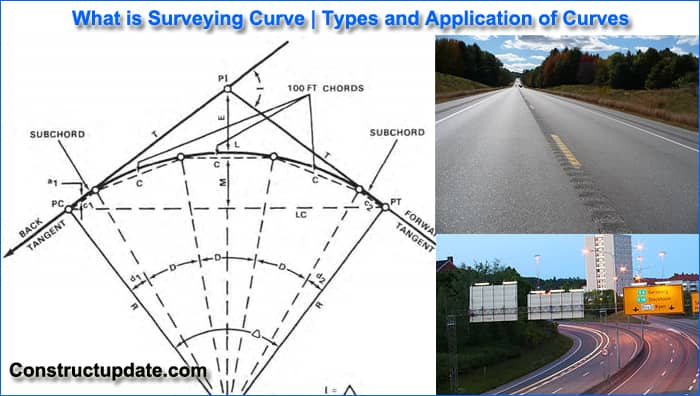What Is Curve?
On highways and railroads, curves are frequently used to change the orientation of a route. They may bend vertically or horizontally. If two points are located at different levels, a curve must be given.
This curve usually connects the places at different elevations in a way that makes it simple, safe, and comfortable for vehicles to travel that path. When vehicles are properly aligned or curved, they may move from one place to another more smoothly.
At the crossroads of two straights, a curve is added to create a gradual shift in direction. This shift in direction could occur in either a vertical or horizontal plane. Therefore, the route is given a curve in accordance with its direction, i.e., either in a vertical plane or in a horizontal plane. In this article, we will try to understand different types of curves in surveying and their applications.


Types of Curves in Surveying
There are two main types of curves accessible for the ease and comfort of the drivers on the road, namely:
- Horizontal Curve
- Vertical Curve
1. Horizontal Curves in Surveying
Horizontal curves are available to change the alignment or direction of a route. Horizontal curves are circular curves or circular arcs. A curve becomes steeper as the radius shrinks, increasing its risk and danger. The main design requirement for a horizontal curve is an adequate safe stopping sight distance.
Types of Horizontal Curves in Surveying
There are primarily five different types of horizontal curves. Those horizontal curves are the following:
A. Simple Curve
It is a circular curve made up of a single, uniform-radius arch. The radius can be typically represented as the angle subtended at its center by a chord of 30 meters.
B. Compound curve
This curve is made up of multiple simple curves with varying radii that turn in the same general direction. In order to prevent cutting or filling, this kind of curve is employed. When a road must be laid out to match a specific terrain, such as a layout between a river and a cliff, or when the bend must follow a particular direction, they become benefits.
C. Reverse curve
This type of curve is formed by two straight lines with the same radius or one with a different radius that turn in the opposite direction. These curves are suitable for lines located in steep terrain as well as those crossing tracks in station yards. The deviation curve is a circular curve made up of two reverse curves that may or may not be connected by a straight line.
This style of bend is frequently used at accident scenes and during extensive track repairs. This keeps the track on its original path after a detour at the required spot.
D. Transition curve
It is a curve with different radii. This kind of curve’s radius can be any value between infinity and a predetermined fixed value. It offers a gradually changing transition from a straight line to a circular curve and back again.
On a circular curve, it is typically offered at both ends. In order to reduce discomfort caused by the abrupt change in curvature at the intersection of a straight line and a curve, transition curves are provided on roads and railways.
E. Combined Curve
A mixed curve is made up of two curves: a straightforward circular curve and a transition curve. The majority of combined curves are used on highways and railroads.
A circular curve is known as a combined or full curve when transition curves are included at both ends of the curve.
2. Vertical curves
Vertical curves are generally provided when a road or train crosses a ridge or a valley. Vertical curves are available when the level varies between two places. Therefore, a vertical curve is provided to make it easier to navigate between these areas. It makes the car transition smoothly and comfortably.
There are two main types of vertical curves.
- Summit curve
- Valley curve.
A. Summit curve
Summit curves are the kind of curves that are convex in the upward direction. The centrifugal force is acting upward against gravity in this summit curve. The passengers are not bothered by this activity. We design the overtaking and stopping sight distances individually when designing the summit curve.
B. Valley Curve
The type of curve known as a valley curve, also known as a sag curve, has a downward convexity. The vehicle adds more self-weight as a result of the centrifugal force acting downward in the valley curve. An acceptable rate variation of centrifugal force is applied in order to create a valley curve.
Application of Curves
Application of Horizontal Curve:
The horizontal curve is the most crucial component of road geometry. Its primary purpose is to offer a smooth transition curve, which is why it is frequently employed in highway bends. The application of a horizontal curve is what it is.
Application of Vertical Curve:
Additionally, it is a crucial curve for the geometry of roads. The vertical curve is frequently utilized in mountainous areas because it is mostly employed where the road’s gradient changes. The Hairpin bend is another way to use the vertical curve.







